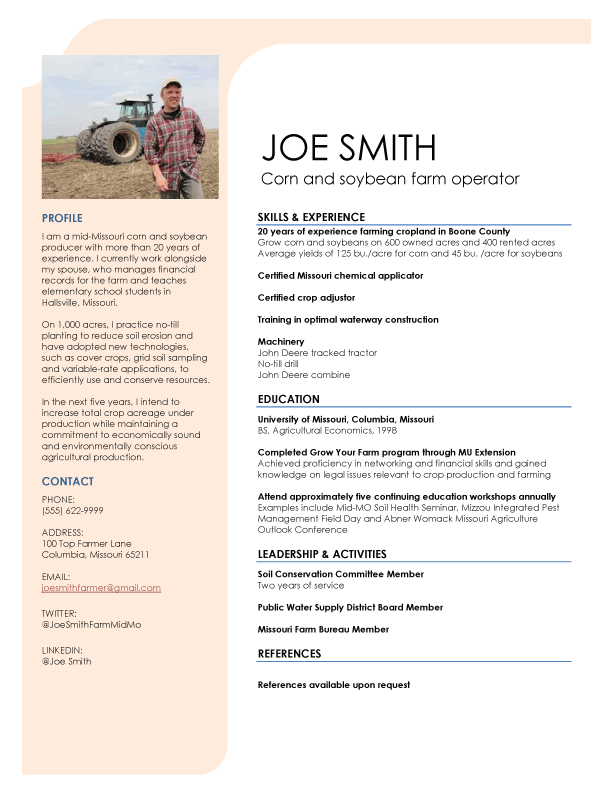In the past few decades, agriculture has experienced enormous change. The 2017 Census of Agriculture shows a decrease in the number of farms and a slight increase in average farm size. At the same time, the average age of all U.S. farm producers has continued to rise. As farmland transitions and operations grow and evolve, competition for rental acreage increases.
Producers who want to rent land must promote themselves and their management abilities to differentiate themselves from the competition. In many cases, they must also educate landowners about agriculture. More farmland is now owned either by landowners who are multiple generations removed from the farm or by investors. These individuals often don’t live near the farm operation, and they may lack on-farm experience of their own.
Communication with a landowner is an important factor in gaining the right to farm the landowner’s ground, and a farm resume is one tool you can use to introduce yourself to landowners. A farm resume is much like a resume for employment in that it highlights your qualifications to do a job. A farm resume can help tenants to creatively promote their skills, education and experiences. When a lease takes shape as a crop-share or flexible cash rent agreement, a landowner will likely have particular interest in the tenant’s skills because the tenant’s performance affects the landowner’s income potential.
This publication outlines ways for you to communicate your qualifications as a producer and a prospective tenant farmer. Sharing your story can be accomplished through distributing a traditional paper resume or using social media such as LinkedIn.
Developing resume content
A printed or online resume should concisely convey a summary of your skills, experiences and accomplishments. Remember, you are promoting yourself, and you want readers to get an idea of who you are and why they should choose you. The resume should include the following elements:
Biographical background
Provide some background information about yourself such as how and when you became involved in farming, where you live and how many acres you farm already. Be sure to include information about your spouse and other family members. If you employ on-farm workers or partner with other farmers, then briefly summarize the team that works with you.
Education
Include your formal education, such as degrees completed, certificates held, and continuing education experiences. List any seminars, conferences or workshops that you attend regularly.
Leadership
Add examples of your community, state or national leadership activities. This would include participation in boards, cooperatives, state commissions or committees.
Skills and experiences
Provide information about your skill set and farming experiences. Include use and knowledge of technology (e.g., GPS, autosteer, yield mapping/monitoring, apps). Add any work you do with custom-farming, crop, livestock or value-added enterprises. List licenses or advanced training certifications you have received. Share examples of the major types of equipment that you use. Make note of those pieces of equipment that improve production efficiency or protect the environment, such as tracked tractors for reduced soil compaction.
When you can, quantify your farm accomplishments to add detail to your resume. If you maintain a farm website, blog or social media page, then consider providing links to those pages, so landowners can review them and get to know you and your operation better.
References
You should be able, if asked, to give references. One-liners from landowners who know your work may be included in your resume. If you utilize LinkedIn, then request references to write and post comments about your experience in your profile’s recommendations section.
Include financial institutions where you handle the majority of the banking for your farm business, and you could consider your insurance agent as another reference contact. You should always obtain permission from all references.
Photograph
If possible, then provide a photo of yourself. On LinkedIn, you should upload a profile picture to your account. When choosing a photo, be conscious of what you are wearing, your facial expression and backgrounds. You may want to provide photos of your home operation to show the landowner the pride and care you take in your work. Be sure to pick photos that depict your operation and yourself in a positive light.
Putting it in print
The purpose of your farm resume is to summarize and give a good impression of your qualifications as a prospective tenant. As a rule, consider these tips for a printed resume.
- Limit the resume to one page.
- Use a font that is easy to read on white or off-white resume paper.
- Avoid cluttered pages by using appropriate margins (suggested 1-inch margins all around) and adding extra spacing before subheadings.
- Proofread your work — more than once — or ask someone to review it for you.
- Update your resume as your farming operation changes.
- See the sample farm resume (Figure 1).

Publishing an online profile
A LinkedIn profile may serve as an online resume where prospective tenant farmers can share information that a landowner might consider when selecting a farm lessee. When creating a LinkedIn profile, note these best practices:
- Write a headline that uses keywords to highlight your value proposition.
- Develop a summary or “about” statement that shares your farming philosophy, expertise, successes and interests.
- Upload visuals such as photos or videos to share more about you and your operation, and provide links to a farm website or blog if you maintain and regularly update one.
- Complete your profile’s experience, education and skills sections, and make note of awards, honors and organizational involvement.
- Keep your contact information current.
- Don’t stop at creating the profile, but continue engaging by posting updates and liking, sharing and adding comments to others’ posts and connecting with new contacts to build your network.
- Be authentic and professional in your interactions.
- See the sample LinkedIn profile (Figure 2).
